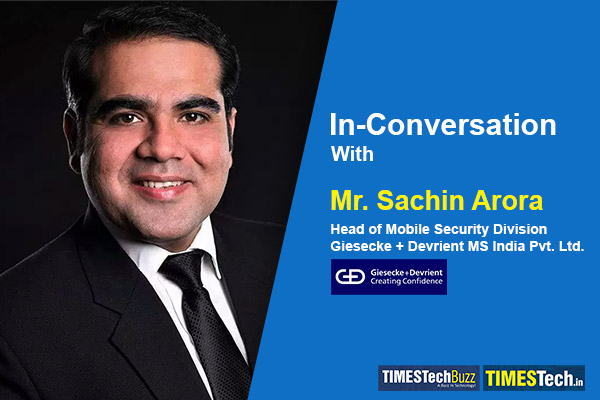In a conversation with Mr. Sachin Arora, Head of Mobile Security Division at Giesecke + Devrient MS India Pvt. Ltd., TimesTech explores how E-Sim technology is spearheading environmental stewardship in the digital realm. Arora highlights the eco-friendly advantages, from reducing plastic usage to enhancing energy efficiency. The interview delves into the synergy between E-Sim, IoT, 5G, and renewable energy sources, outlining opportunities, challenges, and initiatives shaping a greener digital landscape.
Read the full interview here:
TimesTech: How has the green revolution impacted the virtual world of E-Sim, and what role does sustainable technology play in shaping the future of digital environments?
Mr Sachin: Commercially available SIMs have been around for more than 30 years now, and throughout that time, the shift towards a more digital society, as well as awareness of sustainability problems, has been accelerating. eSIM is almost the logical evolution and innovation to help address the green revolution, while helping shape the future of digital connectivity. With eSIMs, the traditional physical SIM cards are no longer necessary, leading to a range of sustainability benefits. Firstly, the production process for mobile and IoT devices incorporating eSIM technology inherently reduces environmental impact. Since the SIM is embedded within the device itself, there’s no need for extra production or shipping of physical SIM cards.
Furthermore, the absence of physical SIM cards means a reduction in plastic usage and shipping materials, contributing to a decrease in CO2 emissions. The streamlined production and distribution processes associated with eSIMs also result in lower energy consumption and fewer logistical complexities. Additionally, the versatility of eSIMs allows for multiple profiles, enabling consumers to switch network providers without requiring a new physical SIM card. This not only enhances convenience but also further reduces the environmental footprint associated with SIM card production and distribution.
The adoption of eSIM technology also facilitates the creation of smaller, sleeker, and lighter devices, potentially reducing energy requirements for transportation. Overall, eSIMs represent a significant advancement in sustainable technology within digital environments, offering tangible benefits for consumers, IoT users of all sizes, and the planet.
TimesTech: In the context of E-Sim, how is the Internet of Things (IoT) being utilized to enhance environmental monitoring and resource management, contributing to a more sustainable and eco-friendlier virtual ecosystem?
Mr Sachin: The introduction and adoption of eSIM technology within the Internet of Things (IoT) has enhanced environmental monitoring and resource management, fostering a more sustainable virtual ecosystem. Previously, IoT devices faced limitations such as wired connections or the need to have a pluggable SIM which often needed to be activated manually. However, with eSIMs, devices are now embedded with connectivity options, offering flexibility in network providers without compromising mobility or energy efficiency.
Moreover, the advent of 5G networks further enhances sustainability efforts by facilitating high-speed, low-latency data transmission. This enables real-time monitoring and control across various sectors, including energy-efficient manufacturing, optimized agricultural practices, and smarter urban planning. For instance, 5G-powered IoT sensors enable precise asset monitoring, automated maintenance scheduling, and data-driven decision-making in agriculture, industry, and smart cities.
Overall, the synergy between eSIM technology, IoT, and 5G networks exemplifies how innovation can drive sustainability. By reducing energy consumption, optimizing resource usage, and promoting more eco-friendly practices, this integration paves the way for a greener and more efficient digital future, aligning with global efforts for environmental preservation and climate action.
TimesTech: What innovative strategies and technologies are being employed in E-Sim platforms to promote energy efficiency, reduce carbon footprints, and align with the principles of the green revolution?
Mr Sachin: In the realm of eSIM platforms, innovative strategies and technologies are actively employed to champion energy efficiency, minimize carbon footprints, and uphold the principles of the green revolution. eSIM management leverages digital services and remote provisioning, eliminating the need for physical interactions and reducing energy consumption associated with traditional SIM card logistics. Moreover, eSIMs boast a sustainable design, devoid of plastic materials and bulky packaging, further mitigating environmental impact.
By facilitating digital sales channels, eSIM platforms eliminate the need for customers to travel to physical stores, thereby reducing transportation-related emissions. Additionally, the compact nature of eSIMs enables leaner device designs, eliminating the need for SIM card holders and conserving space. Independent research from Fraunhofer IZM confirms the environmental superiority of eSIMs over traditional SIM cards, with eSIMs exhibiting a 46% reduction in CO2 emissions across their lifecycle.
Furthermore, eSIMs demonstrate enhanced energy efficiency compared to their traditional counterparts, contributing to overall sustainability efforts. Through these advanced approaches and technologies, eSIM platforms play a pivotal role in advancing environmental stewardship and aligning with the objectives of the green revolution.
TimesTech: How do advancements in renewable energy sources intersect with E-Sim platforms, and what opportunities and challenges arise in incorporating clean energy solutions into the virtual landscape?
Mr Sachin: Advancements in renewable energy sources intersect with E-Sim platforms by catalyzing the integration of clean energy solutions into the virtual landscape. As homes, businesses, and cities embrace smart technologies and IoT devices, eSIM standardizations facilitate mass adoption, enabling centralized management and data collection. The proliferation of connected devices like smart meters generates valuable data, fostering more accurate predictions for energy usage and enabling dynamic switching between energy sources based on real-time insights. Opportunities arise in optimizing energy use and promoting sustainability in smart infrastructures. However, challenges include ensuring interoperability among devices, addressing cybersecurity concerns, and managing grid stability in the face of intermittent renewable energy sources. eSIM and the management services offered by this could be a path to dealing with these challenges. Balancing these factors is essential to realizing the full potential of clean energy solutions in the virtual landscape, paving the way for smarter, more sustainable cities and infrastructure.
TimesTech: As the digital realm continues to expand, how can E-Sim communities contribute to global sustainability efforts, and what initiatives or practices are being adopted to foster a greener and more environmentally conscious virtual world?
Mr Sachin: E-Sim communities play a crucial role in global sustainability efforts by promoting eco-friendly practices and initiatives within the digital realm. By leveraging technologies like eSIM management, these communities reduce the environmental footprint of traditional SIM cards through decreased material usage, packaging waste, and logistics emissions. Initiatives such as digital sales channels and remote provisioning further minimize carbon emissions associated with physical stores and transportation.
Additionally, eSIM platforms facilitate the adoption of remote management of renewable energy sources and contribute to energy efficiency in smart infrastructures. Through centralized management and data collection enabled by eSIMs, initiatives for optimizing energy use and promoting sustainability are advanced. Furthermore, collaborations with mobile network operators and adoption of GSMA standards like SGP.32 ensure interoperability, compatibility and scalability with the IoT, which in turn could foster a more connected, data-driven, greener and more environmentally conscious virtual world.
Initiatives such as 5G adoption also play a crucial role in accelerating the shift towards sustainability, as faster and more efficient data transmission enables smart solutions for energy management, transportation, and resource optimization.
In essence, by embracing green eSIM practices and initiatives, e-Sim communities contribute significantly to global sustainability efforts, paving the way for a more environmentally conscious digital future.















